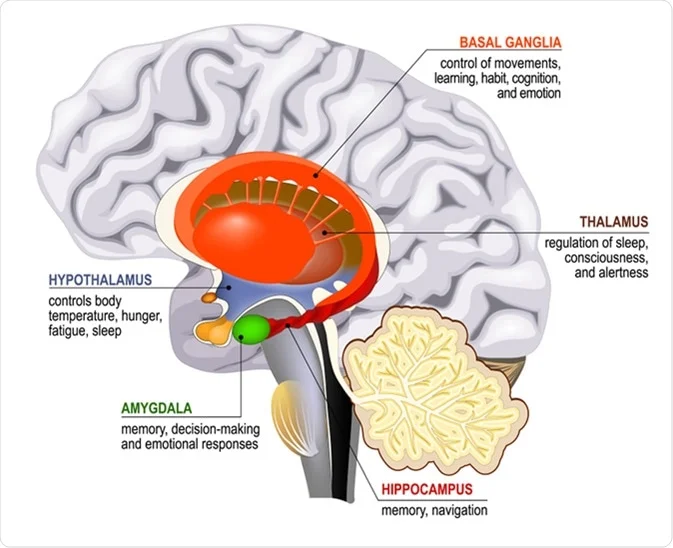Social Issues
Welfare Schemes and Brain Development
- 15 Jul 2023
- 5 min read
For Prelims: Hippocampus, Anti-Poverty Policies
For Mains: Relationship between poverty and brain development, Importance of investments in social safety net programs
Why in News?
Recently, a study published in the journal Nature has shed light on the impact of welfare schemes on brain development, particularly in children from low-income families.
- The study, based on brain scans of over 10,000 children aged 9-11 from 17 U.S. states, aimed to explore the relationship between poverty and brain development and the role of anti-poverty policies in mitigating its effects.
What are the Key Highlights of the Study?
- Poverty's Effect on Brain Development:
- Previous studies have consistently demonstrated that growing up in low-income families can adversely affect brain development and cognitive abilities.
- In 2015, three studies reported that human children and young adults growing up in low-income families had lower cortical volume and did relatively poorly in tests for academic performance. The cortex is the outer layer of the brain.
- Children from low-income families showed a higher risk of having a smaller hippocampus, a structure crucial for learning and memory.
- Impact of Anti-Poverty Policies:
- Generous anti-poverty policies were found to substantially lower the risk of a smaller hippocampus in children from low-income families.
- The size of the hippocampus correlated positively with family socioeconomic status.
- Researchers found a significant three-way interaction between family income, cost of living, and cash assistance programs in predicting hippocampal volume.
- In low-income households residing in high-cost-of-living states, and received generous cash benefits, their hippocampal volumes were, on average, 34% larger than those who lived in low-income households in states with a relatively higher cost of living and lower cash benefits.
- Welfare Schemes and Mitigating Biological Effects:
- Access to more financial resources through welfare schemes can shield families from chronic stressors associated with low income, potentially influencing hippocampal development.
- Anti-poverty policies can reduce stress levels and allow families to make decisions that lead to decreased stress, such as working fewer hours.
- Future Implications and Limitations:
- Longitudinal Study:
- The researchers plan to examine how policy changes since the data collection period have influenced the mental health and brain development trajectories of the participants.
- Monitoring the long-term impact of policy changes can provide valuable insights into the effectiveness of anti-poverty measures.
- Addressing Socioeconomic Disparities:
- The study highlights the importance of investments in social safety net programs to address socioeconomic disparities in neurodevelopment.
- Such programs can potentially lower the costs associated with mental health, education, and economic challenges resulting from socioeconomic inequalities.
- Longitudinal Study:
What are the Major Poverty Alleviation Programs in India?
- Integrated Rural Development Programme (IRDP)
- Pradhan Mantri Awaas Yojana
- National Old Age Pension Scheme
- Mahatma Gandhi National Rural Employment Guarantee Act (MGNREGA) 2005
- Deendayal Antyodaya Yojana - National Rural Livelihood Mission (DAY-NRLM)
- National Urban Livelihood Mission
- Pradhan Mantri Kaushal Vikas Yojana
- Pradhan Mantri Jan Dhan Yojana
UPSC Civil Services Examination, Previous Year Questions (PYQs)
Prelims
Q. In a given year in India, official poverty lines are higher in some States than in others because (2019)
(a) poverty rates vary from State to State
(b) price levels vary from State to State
(c) Gross State Product varies from State to State
(d) quality of public distribution varies from State to State
Ans: (b)
Exp:
- In India, poverty is estimated at absolute level or the minimum money required for subsistence. Presently, the poverty line is defined as the minimum money required for maintaining a per capita caloric intake of 2,100 calories in an urban area and 2,400 calories in a rural area.
- Thus, according to the Poverty Estimates (2011-12) of the Planning Commission, the poverty lines vary from State to State because the price of per capita goods varies due to interstate price differentials.
- Therefore, option (b) is the correct answer.
Mains
Q.“The incidence and intensity of poverty are more important in determining poverty based on income alone”. In this context analyse the latest United Nations Multidimensional Poverty Index Report. (2020)







